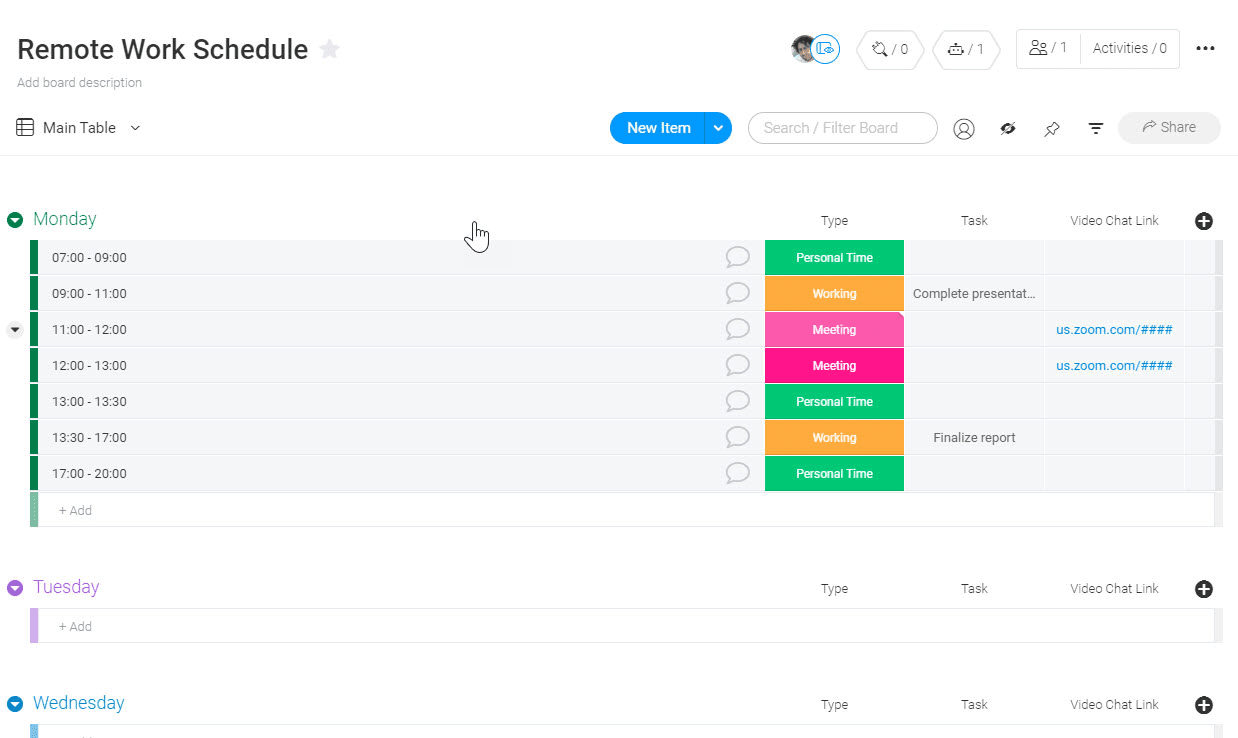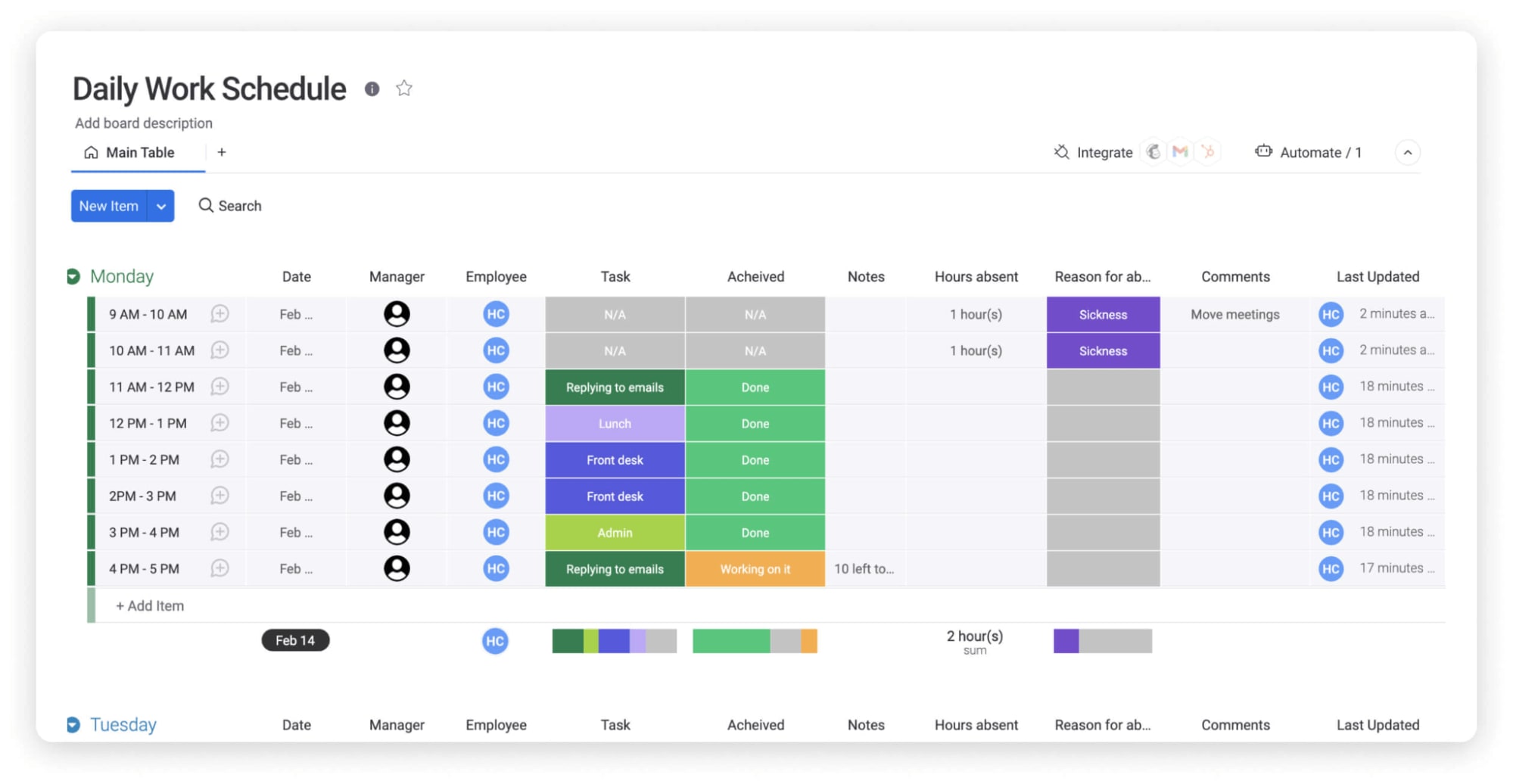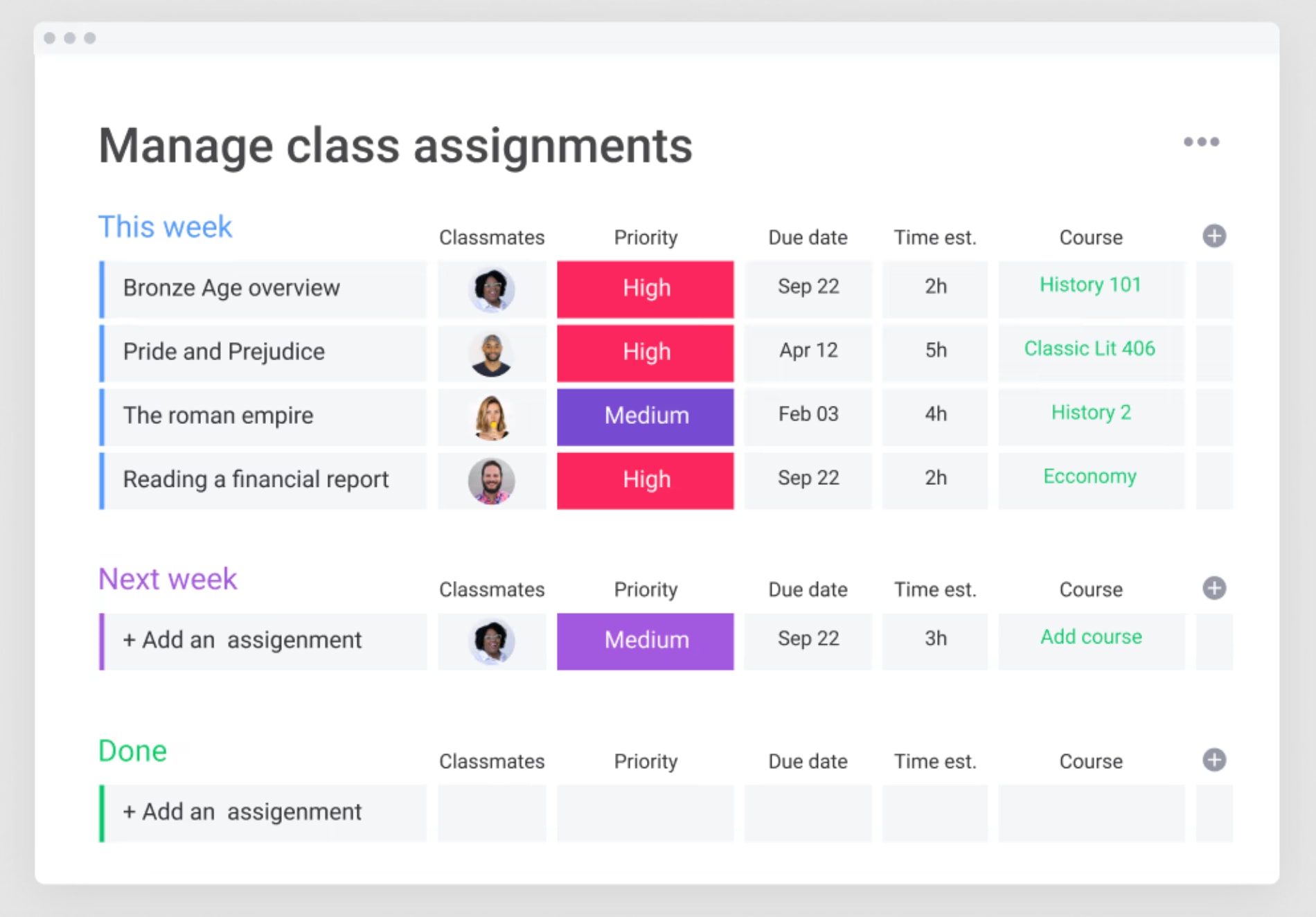Even the most carefully planned projects rarely unfold exactly as expected. Deadlines shift, resources move, and priorities evolve along the way. Understanding how far your timeline has strayed from the original plan is key to keeping work on track and making informed decisions when adjustments are needed.
Schedule variance helps you do exactly that. It measures the difference between planned and actual progress, turning project performance into clear, actionable data. Instead of relying on assumptions, you can see whether your team is ahead, behind, or right where it needs to be — and what that means for overall performance and cost.
Throughout this guide, you will learn what schedule variance is, how to calculate it, and how modern work management platforms simplify tracking so teams can stay aligned and deliver projects on time.
Key takeaways
- Understand schedule variance: this metric compares completed versus planned work in dollar terms, showing if a project is ahead or behind schedule.
- Track progress consistently: weekly monitoring helps identify delays early so teams can adjust resources and timelines before issues escalate.
- Automate insights with monday work management: real-time dashboards calculate schedule variance automatically, while AI highlights at-risk work before deadlines slip.
- Apply the right formula: use Earned Value minus Planned Value (EV – PV) to turn progress updates into clear, measurable data.
- Combine schedule and cost metrics: tracking schedule variance alongside cost variance gives a complete view of overall project health.
What is schedule variance?
Schedule variance (SV) measures how closely a project’s actual progress aligns with its planned timeline. It represents the difference between the value of work completed and the value of work that was scheduled to be completed by a specific date. The result, expressed in dollar terms, shows whether a project is ahead of schedule, behind, or progressing as planned.
This metric gives project managers a clear view of timing performance and helps translate schedule progress into measurable business impact. By identifying where progress has slipped or accelerated, teams can make informed adjustments to resources, priorities, and timelines before small variances turn into major delays
Schedule variance in project management
In project schedule management, schedule variance acts as your early warning system. It catches timing issues before they spiral into major delays.
Project managers rely on this metric because it replaces assumptions with measurable insight. Instead of broad updates like “we are running a bit behind,” it provides clear data that shows exactly how progress compares to the original plan. This clarity makes it easier to identify where adjustments are needed and keep projects moving forward with confidence.
How schedule variance fits into earned value management
Schedule variance is one piece of earned value management (EVM), a system that tracks project performance using budget values. EVM uses three core measurements to give you the full picture:
- Planned Value (PV): the budgeted cost of work you planned to complete by now.
- Earned Value (EV): the budgeted cost of work you actually completed.
- Actual Cost (AC): the real money you spent on completed work.
Schedule variance uses only planned value (PV) and EV, keeping the focus on timing rather than spending. This separation helps you tackle schedule problems without mixing them up with budget issues.
The schedule variance formula
The formula is simple: SV = EV – PV. Older terminology sometimes expresses the formula as SV = BCWP – BCWS, which means the same thing.
A positive result means you’re ahead of schedule. A negative result means you’re behind. Zero means you’re perfectly on track.
Breaking down BCWS and BCWP
At first glance these acronyms might look complicated, but don’t worry as they represent straightforward concepts that help you track project timing:
- BCWS (Budgeted Cost of Work Scheduled): this is your baseline — the dollar value of work that should be done by your measurement date according to your original plan.
- BCWP (Budgeted Cost of Work Performed): this is your reality — the budgeted dollar value of work actually completed by that date.
Remember, both use budgeted amounts, not actual costs. This keeps your schedule measurement separate from budget tracking.
Understanding the SV calculation
When you subtract BCWS (Budgeted Cost of Work Scheduled) from BCWP (Budgeted Cost of Work Performed), you are essentially measuring how much work has been completed compared to what was planned. The calculation converts various types of work into a single financial measure, expressed in dollars.
This approach allows project managers to evaluate performance consistently across different phases and teams, providing a unified view of progress similar to an S-curve analysis.
How to quickly calculate schedule variance
Calculating schedule variance takes three straightforward steps. Each builds on the last, creating a logical flow from gathering data to getting your final number.
Step 1: determine budgeted cost of work scheduled
Look at your project plan and identify everything that should be complete by your measurement date. Include all activities, milestones, and deliverables scheduled for completion.
Add up the budgeted values for all this planned work. This total becomes your BCWS — your baseline expectation.
Step 2: find budgeted cost of work performed
Review what your team has actually finished. Check completed deliverables, closed activities, and achieved milestones.
Calculate the budgeted value of this completed work using your original budget amounts. Don’t use actual costs here — stick with the planned budget values. This total is your BCWP.
Step 3: apply the formula for schedule variance
Subtract BCWS from BCWP to get your schedule variance: SV = BCWP – BCWS.
The result tells you where you stand. Positive means ahead, negative means behind, and zero means on track. The size of the number shows how significant the deviation is.

Schedule variance example: step-by-step
Working through a practical example makes schedule variance easier to understand. Seeing the numbers applied to a real project helps you connect the formula to everyday decision-making and learn how to interpret results effectively.
In this example, let’s imagine you are managing a website redesign project with a total budget of $50,000 and a 10-week timeline. By examining progress at the six-week mark, you can see exactly how schedule variance reveals whether your team is ahead, behind, or right on track.
Sample project scenario
Your project includes five phases with these budgets:
- Discovery and planning: $5,000.
- Design mockups: $15,000.
- Content creation: $8,000.
- Development: $12,000.
- Testing: $10,000.
By week 6, your project schedule shows you should have completed discovery, design, content, and half of development. That’s $34,000 worth of planned work (BCWS).
Working through the calculation
Checking actual progress, you find:
- Discovery: complete ($5,000).
- Design mock-ups: complete ($15,000).
- Content creation: complete ($8,000).
- Development: only 25% complete ($3,000 instead of $6,000).
Your BCWP totals $31,000. Now calculate: SV = $31,000 – $34,000 = -$3,000.
What the results mean
The -$3,000 schedule variance shows you’re behind schedule by $3,000 worth of work. Development is lagging, creating a gap that needs attention.
This concrete number helps you communicate the issue to stakeholders and make decisions. Do you add developers or engage in capacity planning? Adjust the timeline? Reduce scope? The data guides your next steps.

How to interpret your schedule variance results
Understanding what your schedule variance means is just as important as calculating it. The results reveal more than whether your project is ahead or behind — they highlight how well planning, estimation, and execution are working together.
Schedule variance values typically fall into three categories, each offering insight into your project’s performance and guiding how you should respond. Whether the result is positive, negative, or zero, knowing what it means helps you take targeted action to keep work on track and maintain realistic timelines.
Positive schedule variance meaning
A positive SV means you’re ahead of schedule — completing work faster than planned. While this sounds great, dig deeper to understand why.
Are your estimates too conservative? Is the team working overtime? Are you compromising quality for speed? Being ahead isn’t always ideal if it comes at the cost of burnout or rework later.
Negative schedule variance meaning
A negative SV signals you’re behind schedule, and it’s your cue to investigate and act quickly. Research shows that project delays often stem from people-related and process-related risks — like stakeholder involvement or unclear requirements — more so than technical issues.
Common causes include:
- Resource constraints: not enough people or skills available.
- Technical challenges: unexpected complexity or dependencies.
- Scope changes: new requirements added without adjusting timelines.
- Poor estimates: original plans were too optimistic
Identify the root cause first, then develop your recovery plan. Platforms like monday work management can help by showing workload distribution and resource availability in real-time, making it easier to spot and fix bottlenecks and streamline resource scheduling.
When schedule variance equals zero
Zero variance means you’re exactly on schedule — a rare achievement in project management. Your master schedule was accurate, and execution is matching expectations perfectly.
While ideal, consistent zero variance might indicate overly padded estimates or excessive management overhead. Some variance is normal and healthy in dynamic projects.
Schedule variance vs cost variance: differences explained
Schedule variance and cost variance are both core earned value management metrics, but they measure different dimensions of project performance. Understanding how they relate helps you identify whether challenges stem from timing, budget, or a combination of both.
The table below highlights the key differences between schedule variance and cost variance, including what each measures, how they are calculated, and when to use them to evaluate overall project health.
| Metric | What it measures | Formula | When to use |
|---|---|---|---|
| Schedule variance (SV) | Time performance | BCWP - BCWS | Track whether you're on schedule |
| Cost variance (CV) | Budget performance | BCWP - ACWP | Monitor whether you're on budget |

How does tracking schedule variance drive project success?
Regular schedule variance tracking transforms how you manage projects. Instead of discovering delays at the deadline, effective time management in project management helps you spot trends early and adjust while you still have options.
Early detection of schedule issues
Schedule variance reveals problems while they’re still small. A slight negative trend this week becomes a major delay next month if ignored, emphasizing the importance of deadline management.
Early detection gives you more correction options:
- Reallocate resources: shift team members from ahead-of-schedule work.
- Adjust sequences: reorder activities to optimize the critical path.
- Address bottlenecks: remove blockers before they compound.
The earlier you act, the smaller the adjustment needed for resource levelling.
Enhanced resource allocation decisions
Schedule variance data shows exactly where to focus your resources. When certain activities consistently fall behind, they need more support.
This objective data prevents resource allocation based on whoever complains loudest, ensuring more effective resource planning. You can see which areas genuinely need help and which are performing well, and enhance your resource forecasting in the process.
Improved stakeholder communication
Numbers speak louder than opinions, and providing clear metrics is crucial, as employees who understand how success is measured are 2x more likely to feel motivated. Schedule variance gives you concrete data for stakeholder conversations.
Instead of subjective updates, you provide specific metrics: “We’re currently running $5,000 behind schedule, which represents 10% of planned progress. Here’s our recovery plan…”

Transform schedule variance tracking with monday work management
Manual schedule variance calculations eat up time and introduce errors. Monday work management automates these calculations while providing real-time visibility across your entire project portfolio.
The platform integrates schedule tracking directly into your workflows. No separate spreadsheets, no manual math — just accurate, up-to-date variance data whenever you need it.
Automated variance calculations
Automating schedule variance tracking saves time and ensures accuracy as projects evolve. With progress updates recorded in real time, planned and actual completion data stay perfectly aligned.
Within monday work management, timeline views and progress tracking feed directly into variance calculations, giving teams instant visibility into performance without the need for manual updates or complex spreadsheets.
Portfolio-wide schedule dashboards
Executive dashboards show schedule variance across all your projects simultaneously. Spot patterns, identify struggling initiatives, and allocate support where it’s needed most.
These dashboards update in real-time as teams work. Leadership always has current data for strategic decisions, not last week’s outdated report.
AI-powered schedule predictions
The platform’s AI capabilities analyze your schedule variance patterns to predict future performance, tapping into a trend where 86% of IT professionals are already using AI to drive efficiency. Digital Workers monitor project health continuously and flag potential delays before they happen.
These AI assistants can:
- Identify at-risk projects: based on variance trends and historical patterns.
- Suggest resource shifts: recommend moving team members to critical activities.
- Predict completion dates: calculate realistic timelines based on current performance.
Frequently asked questions
What is the difference between schedule variance and schedule performance index?
The difference between schedule variance and schedule performance index is that schedule variance (SV) shows the absolute difference in dollar terms, while schedule performance index (SPI) expresses this as a ratio. SPI equals EV divided by PV, giving you a percentage that makes it easier to compare projects of different sizes.
How often should I calculate schedule variance for my projects?
Calculate schedule variance weekly or bi-weekly for most active projects. High-priority or troubled projects may need daily calculations, while stable, long-term projects might only need monthly reviews.
Can schedule variance work for Agile or Scrum projects?
Traditional schedule variance works best with fixed-scope projects, but Agile teams can adapt it by measuring story points completed versus planned within sprints. This maintains the core concept while fitting in with Agile's iterative nature.
What is an acceptable range for schedule variance?
It depends on your industry and project type. For example, a well-defined construction job may have a tight variance range of ± 3–5%, while research and development projects might allow for ±10–15%. Generally, anything beyond 10% triggers investigation and corrective action.
How do you calculate schedule variance as a percentage?
To calculate schedule variance percentage, divide SV by PV and multiply by 100: (SV ÷ PV) × 100. This percentage format helps compare performance across projects of different sizes and budgets.
Which project management software automatically calculates schedule variance?
Modern platforms like monday work management automatically calculate schedule variance using built-in earned value features. These platforms pull data from your project timelines and progress updates to compute variance in real-time.
